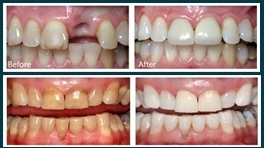1. At home - a tray-based system is used so you can bleach your teeth at home. Your whitening treatment begins with impressions of your mouth so the trays can be custom-fit to your mouth. Once the trays are complete, you'll be given a special solution to place inside the trays before placing them over your teeth for a brief period of time each day until your each the desired level of whiteness. The bleaching agent we use is designed to bubble away stains on the surfaces of teeth without harming the tooth structure or the gums in any way. Plus, you can save your trays for future touch-up treatments.

2. In office – It uses a combination of whitening gels and light activation to help gels penetrate to deeper layers of the tooth surface for significant results in just one office visit. Because it reaches the deeper layers of the tooth surface, results also last longer than many other types of teeth bleaching treatments.
Some types of discoloration cannot be treated with whitening – for instance, discoloration that occurs when the interior portion of a tooth is badly damaged or decayed or following a root canal. In those cases, tooth-colored porcelain veneers or crowns can provide a great solution.
Most staining and discoloration of teeth is related to the foods and beverages that are consumed. Foods and drinks with dark colors, including coffee, red wine, tea, colas, berries and some spices all contain pigments that can stain teeth. Poor oral hygiene habits and infrequent professional cleanings can also contribute to a dull, dingy smile. To prevent staining, brush and floss soon after meals and use a straw when consuming beverages known to stain. Also be sure to have teeth professionally cleaned every six months to remove stains and to learn how to improve brushing and flossing techniques.


